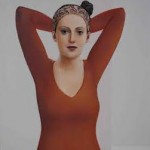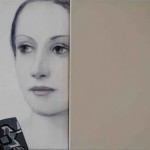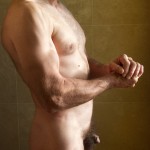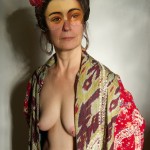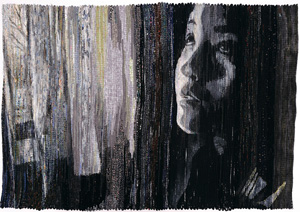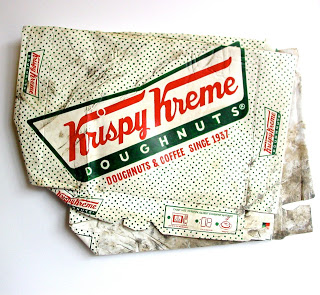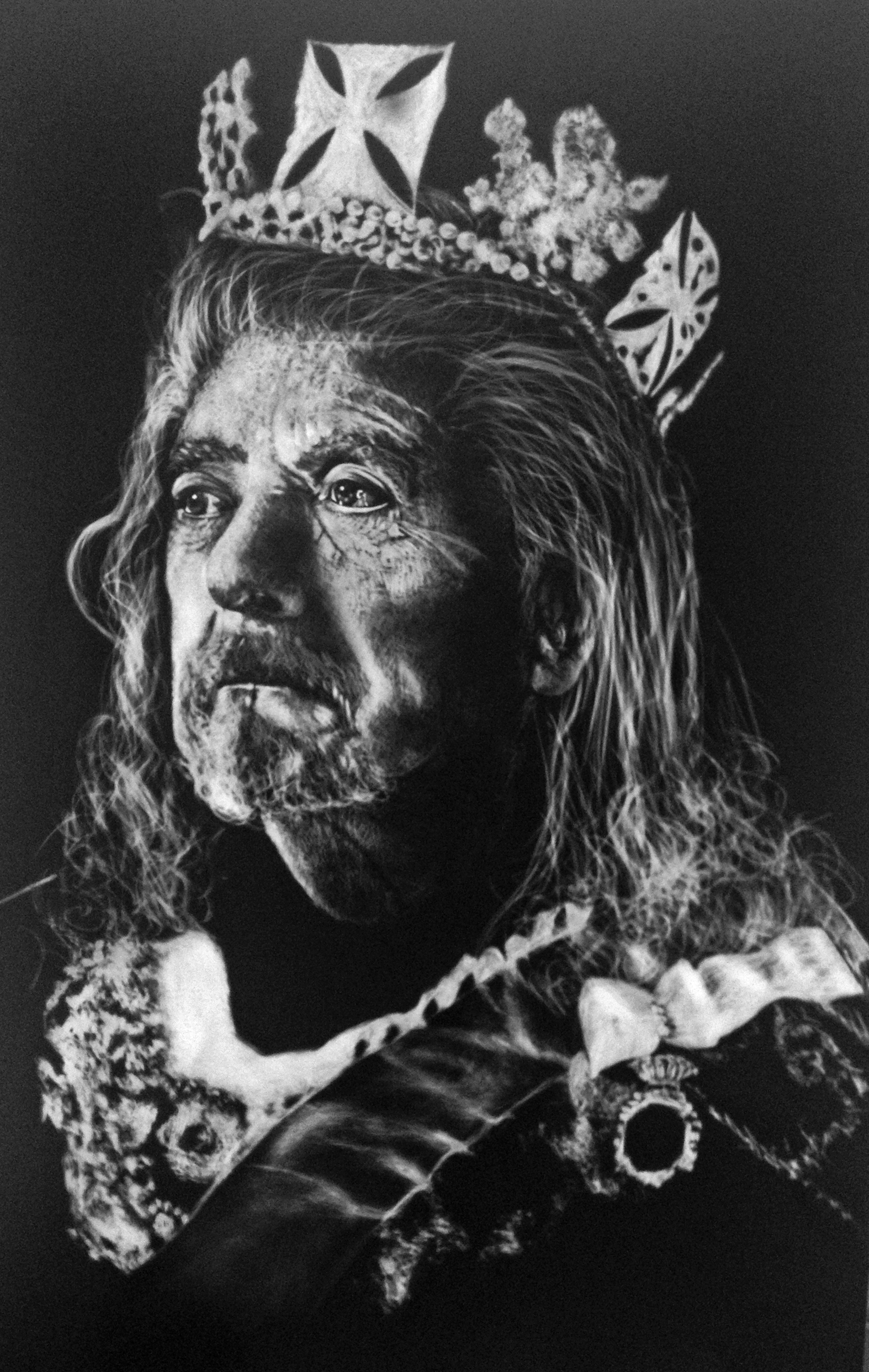John Nation & Sylvia Willkens. Photo-John Nation.
Demoiselle et Garçons: Sylvia Willkens, paintings & John Nation, photographs
Review by Keith Waits
Entire contents copyright © 2014 by Keith Waits. All rights reserved.
Art is a continual rediscovery of what has come before. In the same way that it is often observed that there are only so many plots in literature, visual artists also reach back to reinvent ideas that have come before. For Silvia Willkens, a German-born artist living in Mainz, the great works are a touchstone for her own work in ways that are obvious when you see them. She melds human images that deliberately connote older forms from history with a modern presentation that frames them in a contemporary context. In previous work we can find women who seem born in the Renaissance and seem to have stepped through a portal into our world. They gain a humanity that blows the cobwebs off of their historical foundation and allows us to view them as individuals we could converse with, dine with, come to know and grow to love. That quality of identification reflects the artist’s own attitude towards the period from which she has adopted them; a personal relationship with the classics that leapfrogs the academic and breathes new life into the past. They are no longer of then but entirely of the now.
We might call it a uniquely European sensibility, one that comes from the ease of traveling to visit the community of museums available within a day’s travel if one lives in Germany, France, Italy, England or any of the other countries clustered together in the European Union. For Willkens they are old friends that she has known all her life and with which she feels an intimate connection. She appreciates their greatness, but it does not define her approach. She admires the intensity of the past, when an organic development of all of the creative arts and the understanding of human psychology grew together in synchronicity that may never come again. She talks about how the technology of today might not again allow such a fertile period, one in which giants in all fields functioned in a society that fostered intellectual innovation in a specific city like Paris, at a specific time such as, the early days of the 20th century. Removing oneself to another part of the world simply to see firsthand a painting or sculpture that defines a time and place in history is less important in an age when trans-global communication is available at the touch of a button.
All of which helps us to understand her motivation for seeking inspiration in Pablo Picasso’s Les Demoiselles D’ Avignon (1907). The iconic image of five women in a composition that dates from the famed artist’s Cubist period (has any artist had so many “periods”) is a departure from Willkens’ previous work as a source; less romantic and, even more than 100 years later, less traditional. The dramatic shifts away from the past in art that took such names as ”Cubism” or “Dadaism” remain a challenge for a layman audience even several generations beyond, and continue to provide a foundation for emerging artists seeking to redefine themselves and the art world they occupy.
For Willkens, it is an investigation into potential relationships between contrasting forms that probe beyond surfaces and formal categorization. At first glance, her naturalistic yet lightly idealized human characters seem a distance apart from the aloof, fragmented figures we find in the Picasso painting. Upon further reflection, there is a shared passivity and a somewhat detached perspective employed by the creative hand at work.
Willkens first came to Louisville more than 20 years ago as a part of a cultural exchange with the Sister Cities program. It was then that she encountered Billy Hertz and Tom Schnepf, with whom she became fast friends, and they extended an open invitation to exhibit in Galerie Hertz (then on Market Street). Many extended back and forth visits, the relationship continues unabated by time or distance, and this current show is her third appearance on these walls. Over the years she came to know other Louisville artists and residents and is clearly comfortable here. For this venture, she asked photographer John Nation to participate in her examination of the Picasso Demoiselles and show his work alongside hers.
What is most striking to me about the exhibit is that the pieces that are a direct retranslation of the Picasso are not by any means the most interesting work in the show. Willkens embraces the attachment most passionately, with a large painting that emulates the composition but is contrastingly clean, open and full of negative space next to the busy Picasso. John Nation delivers two takes on the painting which more closely resemble the clashing graphic assemblage of line and texture found in the masterwork, but bring a more mischievous, anarchic tone to bear. These are all fine for what they are: recognition of an academic device to bring two artists momentarily into the same orbit. Willkens’ take on Demoiselles is reverent; Nation’s is satirical.
Silvia Willkens’ delicately rendered portraits mostly focus on the head and face, and when the body is included it is very often clad in a form-fitting brown leotard that obscures detail and emphasizes the sensuality of the form. The expression is passive, almost sphinxlike in its remove, yet sometimes a dreamy, far-off gaze manages to break though the clinical distance and make emotional neutrality strangely compelling. The care and patience that is evident in the craft of the medium is also meaningful. There is love of a kind in these images and it carries through to the viewer.
In four charcoal portraits inspired by Picasso’s “faceless women” who served as muse, Willkens pays tribute to these individuals by bringing them out of the unrecognizable modern forms into which Picasso usually enfolded them. The fact that each face is so tightly contained within the frame of the canvas is alleviated by a diptych format that places an open field of muted color flush against the image, allowing space for the psychological and emotional currents suggested by the introspection. It is a technique this artist has used before on various scales, but here it reinforces the intimacy of the exhibit as a whole and her work in particular.
While Willkens depicts her women with either no environment or only the barest suggestion of one, John Nation takes an opposite approach. Seeing his nude and semi-clothed figures in atmospheric natural landscapes or derelict man-made structures, it is inescapable that this work is not covering new ground. Rather, it reminds us of why the approach is never exhausted, except in the minds of pretentious arbiters of the contemporary art scene. It may be narcissistic, but the fascination of looking at ourselves still has a hold on us, and the nude never loses its ability to invite confessional. We are fascinated, aroused, clinical, offended, uncomfortable, or perhaps all of the above, when confronted with a human form without the trappings that we are accustomed to. The viewer cannot help but be engaged with the textures, spatial relationships, and emotional resonance of the people in these images. Nation is not afraid to embrace prurience to some degree, but it is balanced with feeling and expressions of character, or incorporated contextually in the service of more expansive questions of identity and the human race’s relationship to its sustaining environment. Often there are such themes at work, but at times the pleasures of the flesh, the smooth white expanse of skin or the rough, kinetic energy of a flexed arm and the shifting tonality of the sunbaked skin giving way to the baby-white unexposed areas, are enough.
Both artists share an appreciation for the warmth and plasticity of the human form, and many of the images contain the same passive gaze that establishes neutrality. In Nation’s photographs, one might wonder if it serves to allow comfort for the exposed subject, as if the model might believe there is less vulnerability in the riddance of emotional expression before the camera lens. For Willkens, of course, the objectivity is a choice, but then so is the subtle hint of feeling that informs the expressions. It is not quite pure neutrality, which is in and of itself a misnomer, just a tiny modicum of emotion that proves all the more enticing for how little it registers.
Demoiselle et Garçons: Sylvia Willkens, paintings & John Nation, photographs
April 20-May 31, 2014
Tuesday-Friday 11am-5pm
Saturday 11am-3pm
and by appointment
Galerie Hertz
1253 South Preston Street
Louisville, KY 40201
502-581-8277
galeriehertz.com
- Celestine, Sylvia Wilkens, 2014
- Olga, Sylvia Wilkens, 2014
- Male Nude, John Nation, 2014
- Geisha, John Nation, 2014


